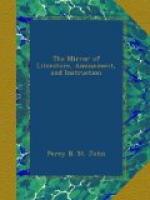* * * * *
CAPE WINES.
The commerce at the Cape is wine; and the vine has already increased tenfold, since the colony became British. But unfortunately more attention has been hitherto paid to quantity than to quality, except on the farms which yield Constantia. The latter have an eastern exposure, and are sheltered from the south-west, the only injurious blast. The soil being a deposit from the neighbouring mountains, is light, but enriched by manure. The subsoil, which is even more important, is still lighter, being mixed with sand and broken stone; on the contrary, in Drachenstein, where the chief vineyards are at present, the subsoil being clay, the wine receives an unpleasant flavour, the idea of which is inseparably associated with the very name of Cape wine. It is unnecessary to enter into the subject of its manufacture. If the subsoil be bad, so will the wine be. The vine does not require a rich subsoil. In Italy, flags are laid to prevent the roots from penetrating into clay; and in England, rubbish is thrown in to make a subsoil that shall not be so rich as to produce leaves, instead of fruit. It would be advantageous were premiums offered for wine that had not been produced from clay of subsoil, but had been reared in trellis, as requiring less labour than the standard, and made on a pure and good system, instead of being mixed with Cape brandy, or sulphuric acid, &c. Notwithstanding all these disadvantages, Cape wine is generally sold in England under the names, and at the prices, of Madeira, Sherry, Teneriffe, Stem, Pontac, and above all, Hock.—Gill’s Repository.
* * * * *
A VIEW OF LONDON.
The finest view in London is from the top of Whitehall Place, looking towards the river; but then you must see it as I did, at the same hour, and under similar circumstances.




